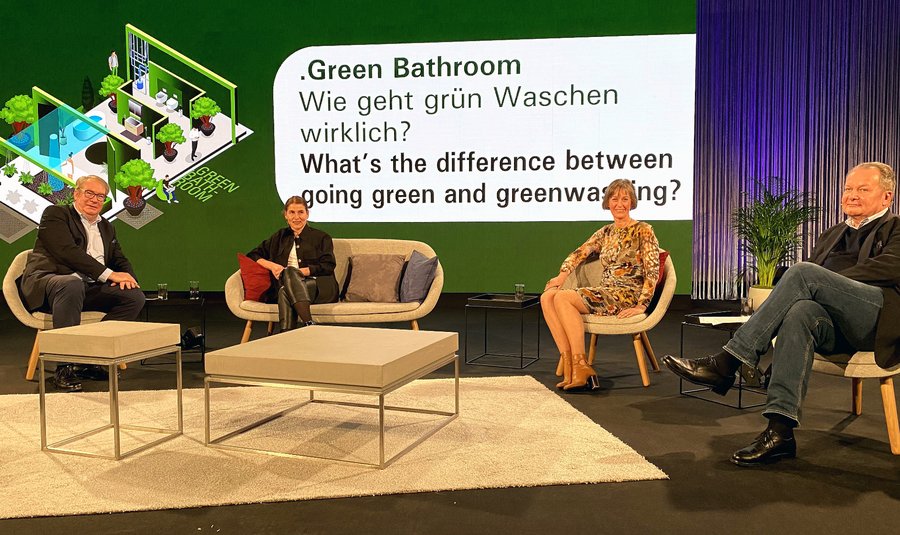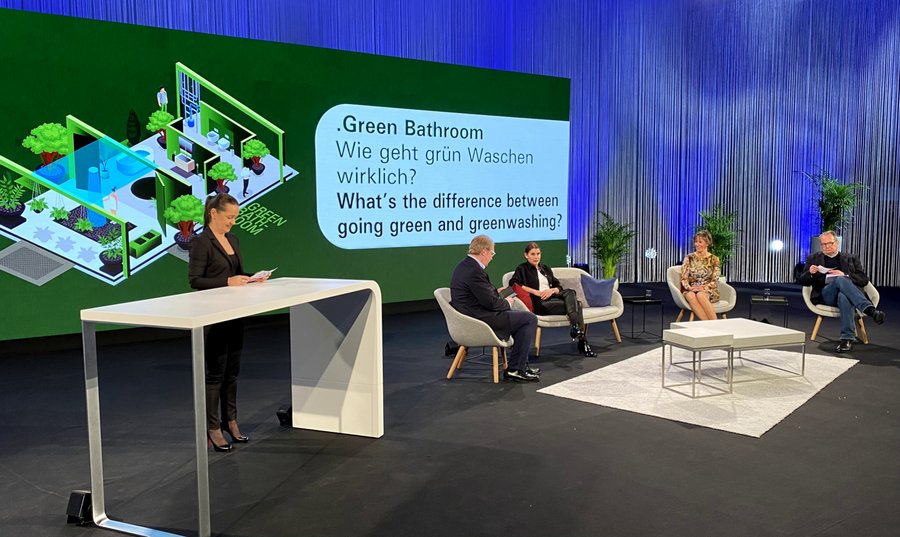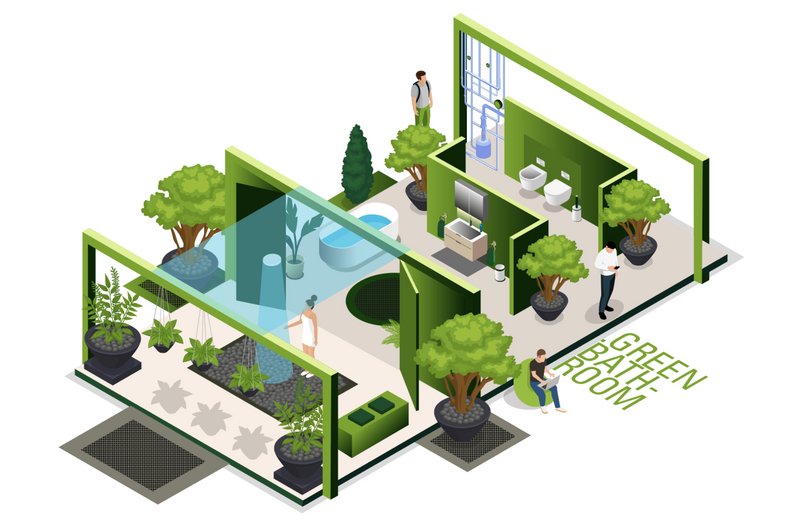Green Bathroom: What’s the difference between going green and greenwashing?

Green
Bathroom was the opening topic for the Pop up my Bathroom Magazine live streams
from the ISH digital 2021. Jens J. Wischmann (VDS) was in a discussion with Yvonne Piu (Kaldewei), Dr. Susanne Sollner (burgbad) and Wolfgang Burchard (VDMA).
Photo: FAR.consulting, Vereinigung Deutsche Sanitärwirtschaft e.V.
Green
Bathroom was the opening topic for the Pop up my Bathroom Magazine live streams
from the ISH digital 2021. And what an important topic it is – “especially
with regard to the subject of climate goals, which is very much on our minds
here at the ISH digital 2021,” as ISH presenter Carina Bastuck pointed out in
her introduction. But what makes for a genuinely sustainable
bathroom, and how are companies implementing it? Jens J. Wischmann, Managing Director
of the German Bathroom Sector Association (VDS) host of the Pop up my Bathroom
Magazine, explored the answers to these and other questions together with four
experts who joined him in the studio.
As Yvonne
Piu, Head of Marketing at Kaldewei, explained: “On the one hand, it goes
without saying that durability, or the useful life of a product, plays an
important role. And on the other hand, there’s the question of
what to do with it afterwards. At Kaldewei, we take a very in-depth approach
to the subject and have been thinking about how we can develop a circular raw
material for a long time now.” Kaldewei’s steel enamel products are designed for
a long lifespan of approx. 30 to 40 years and are then 100% recyclable, meaning
that the material can be used to make the same product again.
Pop up my Bathroom Magazin | Green Bathroom: On the first day of the Pop up my Bathroom Magazine, Jens J. Wischmann will be talking with his guests about sustainable materials and products, discussing the market opportunities for sustainable bathrooms and looking at how companies in the bathroom sector are living sustainability.
For
sustainability expert Dr Susanne Sollner, Head of Innovation/Sustainability Management
at bathroom furniture specialist burgbad, the term sustainability spans three
different areas: profitability, social aspects and ecology. “The only
way to develop the theme and set yourself action areas – whether that means
climate protection, resource conservation or the global supply chain – is to
take a strategic approach to the overall subject. Then you can show that something is
verifiably sustainable – which obviously means backing it up with certification
as well.” Take burgbad’s bestselling Eqio series, for example: it was awarded the
Blue Angel late last year. The eco-label certifies that the bathroom furniture
collection is made of low-emission materials, only uses wood from sustainably
managed forests and has no adverse impact on health in the living environment. In
addition, burgbad has been certified as a climate-neutral furniture
manufacturer since 2016 and carries other labels that verify the company’s
sustainable and ecological practices.
For
Wolfgang Burchard, on the other hand – Managing Director of the VDMA’s Valves /
Welding and Pressure Gas Equipment associations, and as such a representative
of the fittings industry – the sustainability question should focus on the
quality of drinking water: “On the one hand, what goes into the pipe should
come out of the pipe unchanged. And on the other, we don’t want to
waste water – even though we in Germany are lucky in that we have enough.” Responsible
handling of this vital resource is essential; that starts with sustainable
design – in the sense of design that doesn’t chase passing fashions that are no
longer popular a year later – but also includes quality and materials – which
play a significant role with regard to the products both in front of and behind
the wall.

Shortly before the start of the first broadcast: moderator Carina Bastuck prepares for the introduction and the discussion participants around host Jens J. Wischmann discuss the final details.
Photo: FAR.consulting, Vereinigung Deutsche Sanitärwirtschaft e.V.
As Jens J. Wischmann concluded: “It’s clear
that sustainable thinking and sustainability aren’t just a job for product
development; they’re issues that involve the entire company.” And that
doesn’t only apply to the manufacturer’s side of the equation, as was apparent
from a clip featuring Sebastian Fuchs Bad & Heizung, a bathroom and heating
company from the skilled trades sector. Simon Schlese, Commercial Project Manager,
explains how, among other things, the firm plants trees to ensure a low carbon
footprint and how advising customers on sustainability can work. Last but
not least, Hannes Bäuerle Managing Director of Raumprobe, an online materials
database and physical materials exhibition in Stuttgart, joined the
conversation by video to give some examples of the valuable ways in which
modern materials can contribute to a green bathroom. “Especially in the bathroom,”
Bäuerle emphasised, “a multisensory experience plays an extremely important
role. We experience materials from the top of our head all the way down to the
soles of our feet. And that only makes selecting the right
materials all the more important and relevant.” And those materials should be as kind
to the user as they are to the environment.
The lessons
from the first day of the Pop up Magazine: the Green Bathroom and
sustainability are topics that have already been accompanying the bathroom
sector for a long time and permit many different approaches; both manufacturers
and the skilled trades are adopting different areas of focus. At the same
time, companies are becoming increasingly aware of the need to make sustainable
practices and thinking transparent and communicate their commitment to users.
All the
programmes can be viewed in full length on our new YouTube channel.
Further information:
Green Bathroom: 8 facts for ecological bathroom
planning


